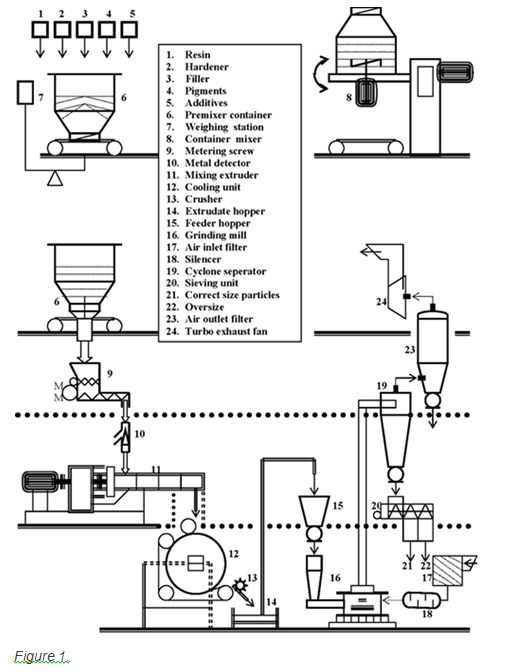Powder Manufacturing and Quality Control
Powder Manufacturing & Quality Control
This section describes the manufacturing and quality control process for powder coating materials. The state of the art technology used for producing industrial powder coatings consists of several distinct stages, namely:
- Weighing, premixing and size reduction of raw materials
- Extrusion of pre-mix, cooling and crushing of the extrudate into chips
- Micronising the chips into the final powder
- Post mixing, packaging and storage.
Weighing, premixing and size reduction of raw materials
Raw materials typically consist of resin, curing agents, pigments, extenders and additives such as flow and degassing aids. Each raw material must pass their individually pre-set quality controls.
Each component is then weighed with the necessary degree of accuracy (which may be to the nearest ten-thousands of a gram). All pre-weighed components are placed in a mixing container according to the formulation. The container is then attached to the mixing drive and the raw materials are thoroughly mixed by the specially designed premixer cutting blades for a pre-set period of time. The raw materials can also be reduced in size to improve the melt mixing later in the process.
Quality control
A final sample of the raw material pre-mix is checked for conformity and processed through a small laboratory extruder and grinder. The resulting powder is then applied onto a test panel, cured in the oven and subjected to various tests:
- Colour, surface flow and gloss
- Mechanical performance (including curing)
- Gel time.
No further modification to the powder can be made after this stage in production.
Extrusion of the premix
The mix is fed into the dosing system of the extruder. The extruder barrel is maintained at a predetermined temperature (between 70 & 120ºC, depending on the product type). The barrel temperature is set so that the resin is only just liquefied and its contents are mixed using the screw in the barrel. Consequently, the individual ingredients are dispersed and wetted by the resin, which produces a homogeneous composite. The feed rate of the dosing equipment and the speed of the extruder screw are balanced to ensure that the screw is kept loaded within the extruder barrel.
The conditions of high shear and intimate mixing are maintained within the extruder by precise adjustments of these three parameters.
The molten mass produced in the extruder barrel is forced to cool down via a cooling-transporting device. The solidified material is then broken up and reduced in size through a crusher into workable chips of 5 to 10mm in size.
Quality Control
At this stage in the process the product quality is tested using a sample of the chips. The laboratory grinds the chips to a powder and prepares a test panel using the material. The intermediate product is then checked for quality against the following criteria:
- Colour, gloss, appearance and flow
- Mechanical and reactive properties
- Application.
It is not possible to make changes to the formulation at this stage in the production process. It is also easier to handle the extruded chip as a re-work raw material if manufactured ‘out of pecification’ than once the powder has been micronised.
Micronising of the chip into the final powder
The chips are ground to the required particle size in a grinding mill. The chips are fed onto an enclosed grinding wheel with stainless steel pins, which breaks the chips down creating a powder. The powder is carried through a classifier into a cyclone collection system via a regulated air flow.
In order to achieve the optimal particle size distribution (psd) further treatment may be needed which can consist of cycloning, classifying, filtering or sieving.

In modern plants the rejected oversize from the sieving operation is automatically fed back into the feedstream of the micronising mill. The typical particle size range for electrostatic application methods should be within 10 to 100 microns. Deviation from this psd can result in poor performance and appearance of the powder.
Quality Control
The final powder coating is as rigorously quality control tested as the extrudate to ensure it meets the specification of the customer or market. As the particle size distribution is a critical factor in the successful use of the powder the particles are analysed for their precise particle size distribution.
Post mixing, packaging and storage
In order to meet the customer specification or special conditions of use additives may have to be mixed through the final product. Powder packaging is provided in:
- carton boxes - up to 25kg
- bags - 400 to 900 kg
- metal/plastic containers (Durabins)
Quality Control
It is advisable to check the powder after 6 months of storage to ensure no quality problems have occurred.
Modern powder coating materials from Akzo Nobel can achieve the same quality standards as liquid coatings for appearance, chemical and mechanical resistance for many applications. Once a product has completed the development stage and its formulation and manufacturing procedures have been approved, it will be available for manufacture in any of Akzo Nobel’s Powder Coating manufacturing plants worldwide.
Document courtesy of AkzoNobel

